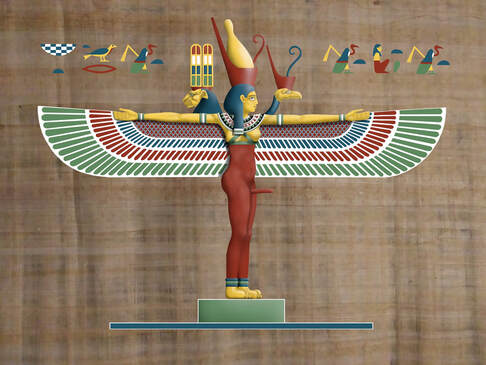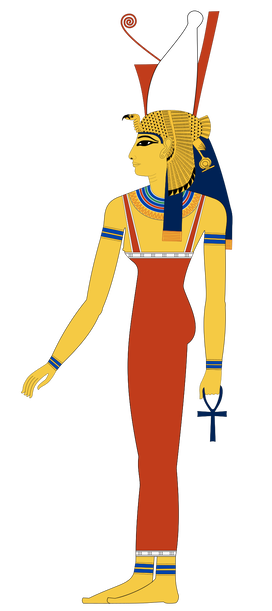Per-Mut
𓅓𓅱𓈗𓏏 𓏏𓅑 𓅐𓏏𓆇𓁐 𓅐𓏏𓊹 𓏏𓅑𓎟 𓅐𓏏𓅆 𓅑 𓅐𓏏 𓏏𓅐𓏏𓆇𓁐
𓅓𓅱𓇋𓇋𓏏/Muit Budge 𓅖𓅱𓇋𓇋𓏏𓁐/Māuit Budge
MDC: mwt
Gardiner: Mwt, Mut
Budge: Mut, Met
Transliteration: Mwt, Mut
Meroitic : Mt (pronounced mata)
Meroitic Cursive : Mt/mata/𐦨𐦴 (pronounced mata)
Old Coptic : Māou/ⲙⲉⲟⲩ
Coptic: Maau, Maav/ⲙⲁⲁⲩ (S), Mau, Mav/ⲙⲁⲩ (S, B), Mout/ⲙⲟⲩⲧ
Māāv/ⲙⲉⲉⲩ (F, sA), Mēou/ⲙⲏⲟⲩ (F), Māou/ⲙⲉⲟⲩ (F), Mo/ⲙⲟ (Sa), Mou/ⲙⲟⲩ (Sa), Mō/ ⲙⲱ (Sa, A)
Hebrew:
Greek: Moyt /Μουτ, Moûth/ Μουθ
Demotic:
English: Mut
Kemetic:
Alt: Maut , Mout
Pronounced: Müt, mu'waʔt (Alt)
IPA : (Old Egyptian, c. 2500 BCE) ˈmiʔwat , ˈmuʔwat (exact quality of the first vowel uncertain) (Middle Egyptian, c. 1700 BCE) ˈmiʔwaʔ , ˈmuʔwaʔ (exact quality of the first vowel uncertain)
(New Kingdom) ˈma:tʰə
(Late Egyptian, c. 800 BCE) ˈmeʔwə ; (modern Egyptological) muːt
Meaning: "Mother" - /mwt/𓅐𓏏𓁐 "mother"
Gardiner: Mwt, Mut
Budge: Mut, Met
Transliteration: Mwt, Mut
Meroitic : Mt (pronounced mata)
Meroitic Cursive : Mt/mata/𐦨𐦴 (pronounced mata)
Old Coptic : Māou/ⲙⲉⲟⲩ
Coptic: Maau, Maav/ⲙⲁⲁⲩ (S), Mau, Mav/ⲙⲁⲩ (S, B), Mout/ⲙⲟⲩⲧ
Māāv/ⲙⲉⲉⲩ (F, sA), Mēou/ⲙⲏⲟⲩ (F), Māou/ⲙⲉⲟⲩ (F), Mo/ⲙⲟ (Sa), Mou/ⲙⲟⲩ (Sa), Mō/ ⲙⲱ (Sa, A)
Hebrew:
Greek: Moyt /Μουτ, Moûth/ Μουθ
Demotic:
English: Mut
Kemetic:
Alt: Maut , Mout
Pronounced: Müt, mu'waʔt (Alt)
IPA : (Old Egyptian, c. 2500 BCE) ˈmiʔwat , ˈmuʔwat (exact quality of the first vowel uncertain) (Middle Egyptian, c. 1700 BCE) ˈmiʔwaʔ , ˈmuʔwaʔ (exact quality of the first vowel uncertain)
(New Kingdom) ˈma:tʰə
(Late Egyptian, c. 800 BCE) ˈmeʔwə ; (modern Egyptological) muːt
Meaning: "Mother" - /mwt/𓅐𓏏𓁐 "mother"
Home:
Temple: Waset/ Thebes/ Θῆβαι/ Thēbai, Ipet-(i)sut 'Southern Harem'/ Temple of Luxor at Karnak, Sudan, Karnak Temple of Amun (New Kingdom)
Nome:
Consort
Amun, Amun-Ra (As Amunet Thebes, Memphis) "Lady of the Nine Arches "
Children
Khonsu (As Amunet Thebes)
Menthu (adopted god of war) Later replaced with Khonsu
Father
None self created
Mother
Siblings
Alternative Parentage
Priest names
Features
Women with headdress of a winged vulture and the crown of Upper and Lower Egypt, holding a Papyrus or Lily-scepter much like Sekhmet in her hand (symbol of UE). Dressed in bright red or blue. Association with Ma'at's feather as well. Sometimes she shows up as a vulture.
Symbols
Vulture
Crescent moon (shape of the scared lake at Karnak who's name is iSrw)
Cobra, cat, cow, lioness (Check under Connections to other gods)
Ka
Queens
Priestesses performed traditional religious rights associated with music and drinking
Lioness (Thebes)
Cat (Thebes)
𓇅 Papyrus or Lily-scepter (Upper Egypt)
Crown of Uraeus (cobra)
Roles
Queen of the goddesses and lady of heaven. A sky goddess and creator goddess mother from which the cosmos emerged. Through out History she absorbed multiple goddesses aspects. Check under Connection to other Gods and Hybrid gods for more info.
Connection to other gods
Amunet- Mother goddess, creator, protector of the King (Mut Absorbed her attributes)
Bastet- Cat, protection, music, joy, dance
Hut-Hor/ Hathor (Assimilated into when Amun became Ra)- Mother goddess patron of women
Nekhbet- Vulture, patron of unified Egypt, mother aspect
Nunet- Primordial goddess
Menhit- Cobra, lioness, war
Meretseger- Cobra, lioness, vulture, patron of workers, protector of royal tombs (Associated w/ Hut-Hor)
Sekhmet- lioness, war
Wadjet- Cobra, protector of kings and women in childbirth
Hybrid gods
Mut-Wadjet-Bast
Mut-Sekhmet (lioness, Thebes)
Mut-Sekhmet-Bast (Wadjet having merged into Bast)
Mut-Sekhmet-Bast-Menhit
Mut-Nekhbet
Mut-Hut-Hor (became Auset/Isis) becoming Auset/Hut-Hor or Mut-Auset-Nekhbet
Celebrations
Opet festival Kemetic New year
Offering items
Other names
Mother Goddess
Queen of the Goddesses
Lady of Heaven
Epitaphs
Hmt nswt nTrwt : Queen of the goddess
irt-ra : Eye of Ra
msi.s : She who gives birth
mwt nTrw : Mother of gods
mwt wrt nbt iSrw Hmt nTrw nbt : Mut the great lady, the lady of Asuru, the Queen of all the gods
nbt iSrw : Lady of Ashru
nbt pt : Lady of heaven
nbt TAwy : Lady of the Two lands
nTrt wrt : Great goddess
nTrw nbw : Lady of all the Gods
tA mut : world mother
nbt-psDt : Mistress of the Nine Arch
mwt.i nwt pS.s dnH n Hr.i : My mother Nut spreads her wings over me
mwt nb iSrw Hnwt nTrw nbw : Mut, mistress of Asheru, lady of all the gods (stela of Tutankhamun)
ref . The Meroitic Language and Writing System By Claude Rilly, Alex de Voogt
Temple: Waset/ Thebes/ Θῆβαι/ Thēbai, Ipet-(i)sut 'Southern Harem'/ Temple of Luxor at Karnak, Sudan, Karnak Temple of Amun (New Kingdom)
Nome:
Consort
Amun, Amun-Ra (As Amunet Thebes, Memphis) "Lady of the Nine Arches "
Children
Khonsu (As Amunet Thebes)
Menthu (adopted god of war) Later replaced with Khonsu
Father
None self created
Mother
Siblings
Alternative Parentage
Priest names
Features
Women with headdress of a winged vulture and the crown of Upper and Lower Egypt, holding a Papyrus or Lily-scepter much like Sekhmet in her hand (symbol of UE). Dressed in bright red or blue. Association with Ma'at's feather as well. Sometimes she shows up as a vulture.
Symbols
Vulture
Crescent moon (shape of the scared lake at Karnak who's name is iSrw)
Cobra, cat, cow, lioness (Check under Connections to other gods)
Ka
Queens
Priestesses performed traditional religious rights associated with music and drinking
Lioness (Thebes)
Cat (Thebes)
𓇅 Papyrus or Lily-scepter (Upper Egypt)
Crown of Uraeus (cobra)
Roles
Queen of the goddesses and lady of heaven. A sky goddess and creator goddess mother from which the cosmos emerged. Through out History she absorbed multiple goddesses aspects. Check under Connection to other Gods and Hybrid gods for more info.
Connection to other gods
Amunet- Mother goddess, creator, protector of the King (Mut Absorbed her attributes)
Bastet- Cat, protection, music, joy, dance
Hut-Hor/ Hathor (Assimilated into when Amun became Ra)- Mother goddess patron of women
Nekhbet- Vulture, patron of unified Egypt, mother aspect
Nunet- Primordial goddess
Menhit- Cobra, lioness, war
Meretseger- Cobra, lioness, vulture, patron of workers, protector of royal tombs (Associated w/ Hut-Hor)
Sekhmet- lioness, war
Wadjet- Cobra, protector of kings and women in childbirth
Hybrid gods
Mut-Wadjet-Bast
Mut-Sekhmet (lioness, Thebes)
Mut-Sekhmet-Bast (Wadjet having merged into Bast)
Mut-Sekhmet-Bast-Menhit
Mut-Nekhbet
Mut-Hut-Hor (became Auset/Isis) becoming Auset/Hut-Hor or Mut-Auset-Nekhbet
Celebrations
Opet festival Kemetic New year
Offering items
Other names
Mother Goddess
Queen of the Goddesses
Lady of Heaven
Epitaphs
Hmt nswt nTrwt : Queen of the goddess
irt-ra : Eye of Ra
msi.s : She who gives birth
mwt nTrw : Mother of gods
mwt wrt nbt iSrw Hmt nTrw nbt : Mut the great lady, the lady of Asuru, the Queen of all the gods
nbt iSrw : Lady of Ashru
nbt pt : Lady of heaven
nbt TAwy : Lady of the Two lands
nTrt wrt : Great goddess
nTrw nbw : Lady of all the Gods
tA mut : world mother
nbt-psDt : Mistress of the Nine Arch
mwt.i nwt pS.s dnH n Hr.i : My mother Nut spreads her wings over me
mwt nb iSrw Hnwt nTrw nbw : Mut, mistress of Asheru, lady of all the gods (stela of Tutankhamun)
ref . The Meroitic Language and Writing System By Claude Rilly, Alex de Voogt




